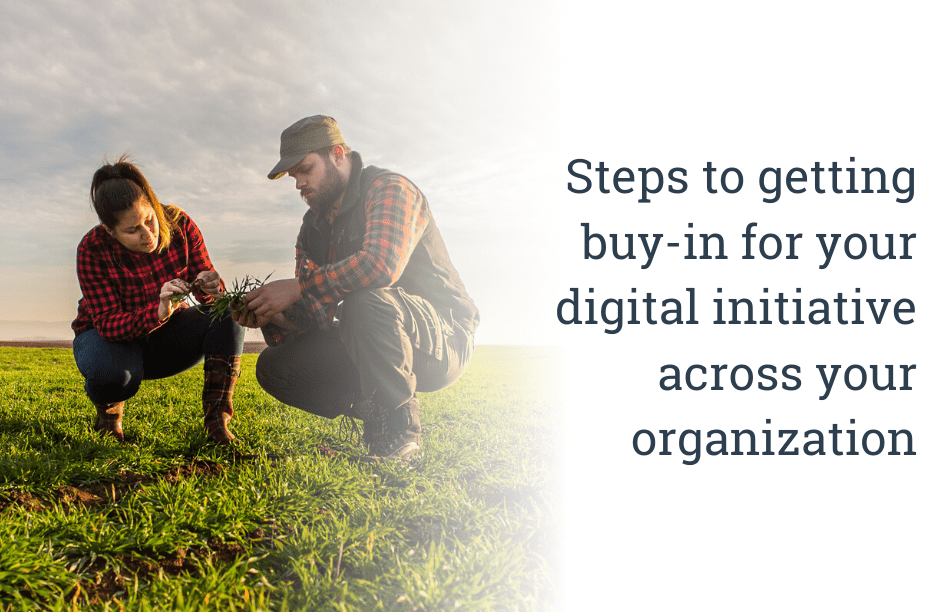
- July 15, 2021
Sharing the “Why” Behind Your Digital Strategy

You have made the decision to implement a digital strategy into your ag retail business. Embracing digital tools can significantly improve the experience for your customers and deliver efficiencies across your organization. However, in order for these initiatives to stick, your team must truly understand the value, not just at the corporate level, but at an individual one as well.
Here at AgVend, we send two books to our customers when they sign on as partners. The first is Extreme Ownership by Jocko Willink and Leif Babin. It helps new partners understand how we do business, and we ask them to hold us accountable to those high standards. The second book is Leading Digital by George Westerman, Didier Bonnet, and Andrew McAfee, and it is chock-full of best practices for launching digital transformations.
Leading Digital has followed me in my career. It first appeared during my days at Euclid where I worked with Fortune 500 retailers, banks, and automotive companies in the midst of rolling out their own omnichannel strategies. Now, 6 years later, the insights in this book are highly relevant for innovative ag retailers embarking on their digital journeys. When it comes to achieving widespread adoption for any new strategy within an organization, the playbook can be found in Leading Digital. Regardless of your end goal, all successful plans begin with a combination of executive team alignment, individual-level buy-in, and a team of champions to evangelize your “why”.
Executive team buy-in
In order for your new strategy to achieve your desired goals, there must be a shared understanding throughout the entire organization as to why digital tools are being implemented. But before introducing the new strategy to the business, you’ll need the full support of your executive team.
“Digital transformation only works when your top team is actually engaged and owns the digital vision,” note Westerman, Bonnet, and McAfree in Leading Digital.
It is best if the first communications on this topic come from the CEO or president directly. The executive team needs a firm grasp on the potential threats, opportunities, risks, and rewards of the initiative. Leadership must be aligned on the initial scope and pace at which this strategy will scale across the company. Having the executives fully bought-in before presenting to the larger organization creates the necessary alignment to share a coherent and consistent vision.
Explaining the “why” to the organization
Executive team alignment is step one, but from there you’ll need to share this strategy with the rest of the organization. This starts with explaining the “why”, as it is imperative to the long-term success of your digital initiative that the reasoning is understood from the top down.
There are two steps of explaining the “why”, and the first begins at the organizational level. What is the reason that the company has decided to invest in a digital strategy and tools for your customers? What are the goals of using this technology? What are the known challenges? Once you introduce the initiative to the organization as a whole, it’s time for step two; get specific. There should be time spent with each department to discuss relevant use cases of the tools and how this will impact an individual team member’s day-to-day.
For example, a sales agronomist is going to meet a customer and wants to see what they purchased in this month last year. Previously, the agronomist would have to grab their laptop, login to their ERP, find the customer, and click through seven different screens to run a report to find the previous purchases. And this is assuming the sales rep was savvy enough to do this and didn’t call their team at the office. This can take anywhere from an hour to half of a day.
Now, all of that information is accessible in a mobile app. With fewer than five taps of the finger, your agronomist has the timely information they need to help the grower make decisions and close the sale. A task that used to take an hour (or four plus) now takes two to five minutes. This is saved time which your agronomist can use to service other customers in a higher value capacity.
Kayd, a crop advisor at Valley Agronomics is one of those team members who has been quick to embrace new digital tools. When pulling up a grower’s order history during a recent training session, he remarked, “This is a piece of cake! This app is going to eliminate a lot of headaches.”
You should remember that digital initiatives often come with a bit of fear for your team. This is natural, change is hard. It is important to identify and label the concerns of individuals. “Are you trying to replace me?” is the most common response when members of a sales team hear about a digital commerce option. Getting this out on the table and addressing it directly will help put your employees at ease.
After this stage, your entire team should be able to answer, “How is this digital strategy going to make my life easier?” for themselves and their teams. In this process, you may find that some individuals are particularly enthusiastic about the initiative and are willing to be among the first to use the new tools to help the transition go smoothly.
Finding champions who will demonstrate and share the value
Your strategy is not something that can be siloed to just the front office. Your team members that are most excited and engaged should form a “coalition of believers” to lead across departments.
It’s usually easy to find these champions. They are, in general, very comfortable with technology and interested in new solutions like Kayd. These team members are the early adopters in your organization who will invest the time and effort to learn how to use new digital tools and share their knowledge with others. Companies with a culture of innovation cultivate these types of employees and reward their commitment.
“These individuals have bought into the vision, the strategy, and the resulting need for transformation,” noted Westerman et al. in Leading Digital. ”They network well and create horizontal influence to help you implement the transformation across silos.”
These champions will help get the early wins, which are crucial for broader adoption. Once others see the success that these early adopters are experiencing with the digital tools, they will be much more apt to integrate into their workflow.
Tying it all together
Once you’ve unified your executive team, gotten buy-in from the individuals across departments, and identified your champions, you’re well on your way to rolling out a digital transformation. These are the first steps in a cohesive strategy and will minimize any roadblocks as your team progresses. Because after all, a digital initiative is meant to help every member of your organization, from the farm gate to the c-suite.
—
AgVend powers the omnichannel experience in agriculture. We provide ag retailers with white-labeled information, engagement, and commerce portals. Our suite of products is designed to strengthen the relationship between ag retailers and their grower customers. The AgVend team is comprised of individuals with backgrounds in agriculture, digital marketing, and omnichannel retail, and operates from dual locations in Minnesota and California.


